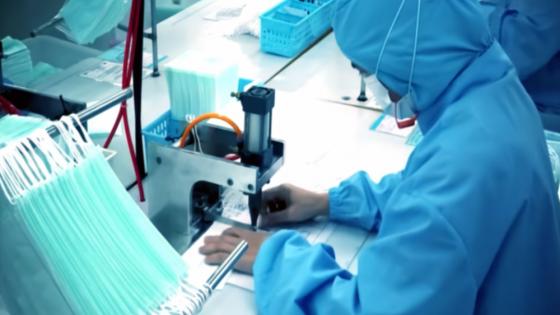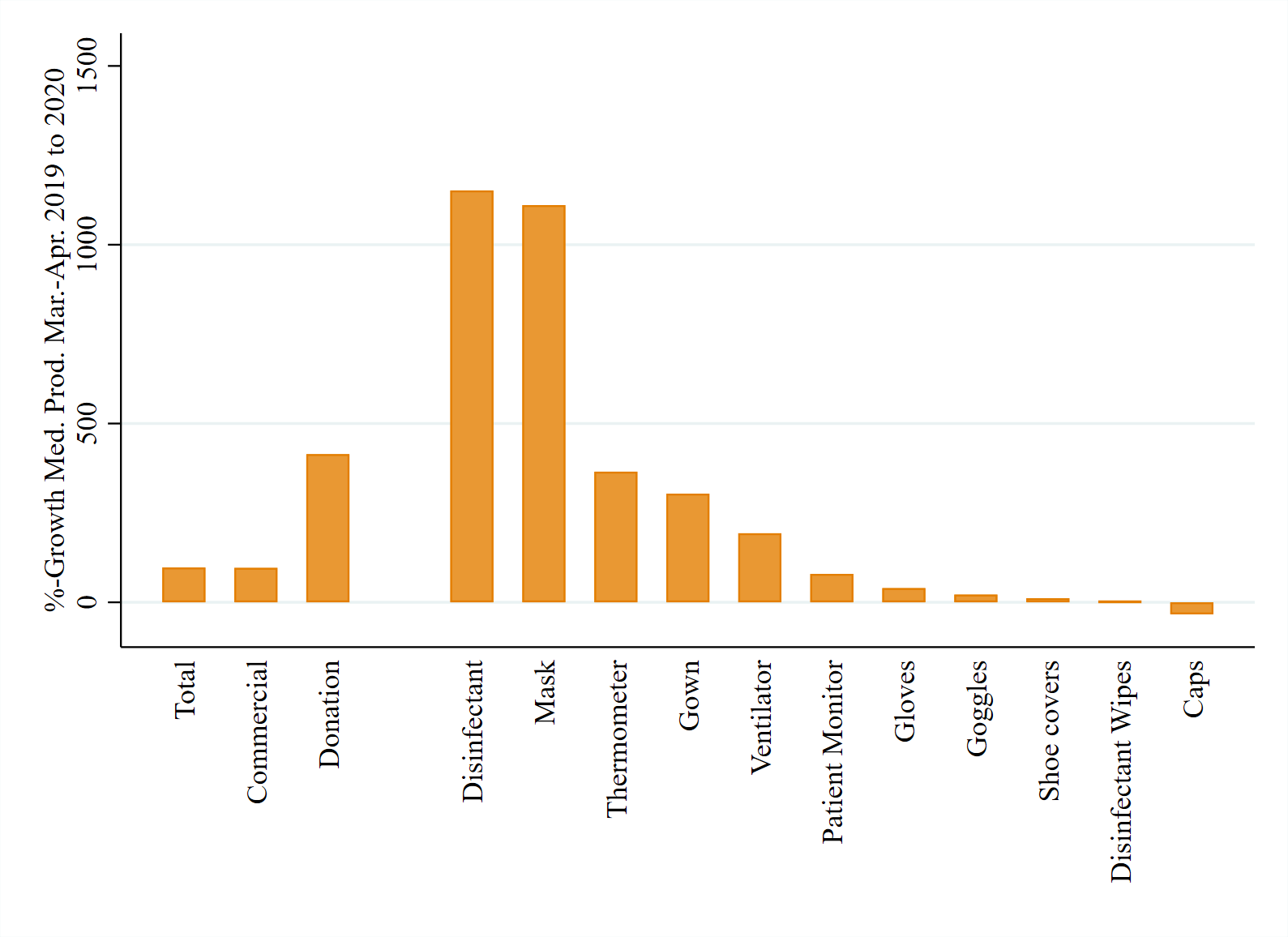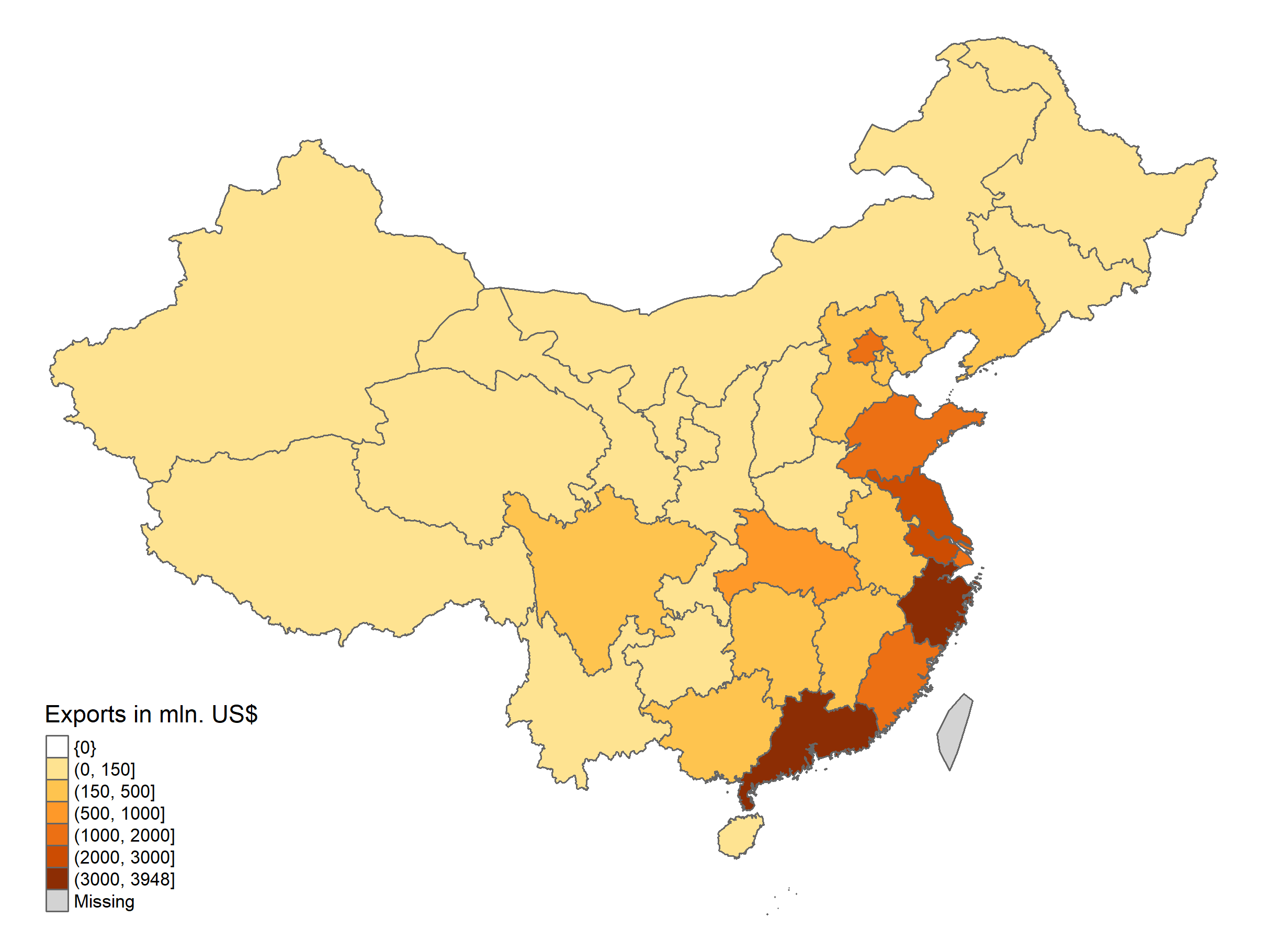It is widely accepted that the usage of face masks helps contain the transmission of COVID-19 (e.g. Mitze et al. 2020), making them a critical medical supply. When the outbreak spread across the world in March 2020, the matter reached a new level of urgency as the demand for critical medical equipment, including face masks and ventilators, skyrocketed and far outstripped the global supply of these goods. The global health crisis has transformed simple medical products into very scarce goods and China, their largest exporter, plays a crucial role in their global supply. According to UN Comtrade (2020) statistics, 44% of the world’s exports of face masks originated from China in 2018, whereas the next largest exporters, Germany (7%) and the US (6%), play a comparatively minor role.
In the wake of the supply shortage, governments, companies, hospitals, and individuals started competing for medical supplies with sometimes questionable means. The Guardian (2020b) reported on 3 April, for example, that “US buyers waving wads of cash [had] managed to wrest control of a consignment of masks as it was about to be dispatched from China to one of the worst-hit coronavirus areas of France.” In another instance, the US was accused of diverting shipments of medical goods designated for Germany from an airport in Bangkok. Politicians reacted by condemning this behaviour as “wild west methods” and an “act of modern piracy” (The Guardian 2020a). But the crisis also led to tensions within countries. The French Interior Minister Christophe Castaner even called the situation within France a “guerre de masques” (a “mask war”) between the local authorities and the state (Le Monde 2020).
China has played the central role in these ‘mask wars’. Due to the shutdown of the Chinese economy, China itself had run short of medical equipment and was dependent on imports in February 2020, when the virus was still mainly within Chinese borders. While global demand for medical equipment from China surged during the outbreak of the pandemic in March 2020, Chinese production capacities recovered and Chinese exports of both disinfectants and masks increased by more than 1000% compared to the previous year (see Figure 1). That way, China helped smoothen shortages due to lockdowns in countries to which the virus spread next (Bamber et al. 2020).
Figure 1 Growth in Chinese medical equipment exports in March and April between 2019 and 2020
Notes: The graph shows the growth rate for total, commercial and donation exports of medical equipment (based on HS 6-digit classification), as well as the growth rate for 11 medical products measured at the HS 8-digit level that are deemed essential by the Chinese government for COVID-19 treatment and control. Data are taken from China Customs (2020). Rates refer to the percent increase between March and April 2020 and the reference months in 2019.
China’s mask diplomacy
Beijing has a track record of using trade to pursue its foreign-policy goals (Fuchs and Klann 2010, Du et al. 2017). Likewise, China’s foreign aid is connected to commercial and geopolitical objectives. For example, countries that have a close voting alignment with China in the UN receive significantly more aid, while countries that recognise the government in Taipei are largely excluded from any aid receipt (Dreher and Fuchs 2012, Dreher et al. 2018).
Figure 2 Exports of medical equipment from China by partner country, March and April 2020
a) Commercial exports of medical equipment
b) Donation exports of medical equipment
Source: Fuchs et al. (2020) with data from China Customs.
A similar dynamic has been observed during this pandemic. As the virus raced around the globe, countries that were hit particularly hard by the pandemic were struggling to attract medical exports to protect their population. Commercial ties, however, were not the only way to obtain more critical medical goods from China. The Chinese government seized the opportunity to “tell China’s story well” (Jacob 2020) and started donating medical equipment to other countries. While China sought discretion from donors such as the EU (when foreign medical supplies were sent to Hubei province in January 2020), the Chinese state media were quick to portray China’s own donations as acts of benevolence (Popescu 2020). Many leaders of recipient countries duly praised China in return. For example, Serbia’s president welcomed a team of Chinese doctors in March 2020 by kissing the flag of the People’s Republic (CGTN 2020). Figure 2 shows that some of the main recipients of Chinese aid were suitably those that were severely hit by an early outbreak (like Italy and Luxembourg). However, high donations to countries like Ethiopia and Hungary can only be explained by other factors which underline China’s ‘mask diplomacy’.
Figure 3 Exports of medical equipment from Chinese provinces to all partner countries, March and April 2020
a) Commercial exports of medical equipment
b) Donation exports of medical equipment
Source: Fuchs et al. (2020) with data from China Customs.
Making guanxi work through sister relations
In a new paper (Fuchs et al. 2020), we analyse the pattern of both commercial exports and aid exports of critical medical goods at the beginning of the global pandemic. We use official monthly data from China Customs (2020) on trade between Chinese provinces and all countries in the world between March and April 2020. Figure 3 shows that every Chinese province exported medical goods during March and April 2020. The distinct subnational variation allows us to assess heterogeneous effects of economic and political ties on medical exports between Chinese provinces and other countries. We use a dyadic specification with country and province fixed effects, which allows us to mitigate potential biases caused by omitted variables driving the demand for medical goods and the localisation of their production.
As visually displayed in Figure 4, we find that there is some path dependency both in commercial exports and donations. Business ties (captured by past foreign direct investment in the province) lead to significantly more commercial exports and donations of critical medical equipment. Beyond business ties, political ties appear to play a crucial role. This can be evinced first, by the fact that China reciprocated donations to countries which sent aid in January and February by providing them with more commercial exports and donations of medical goods during the international outbreak in March and April. Second, and most strikingly, having a sister relationship with a Chinese province more than doubles the volume of medical product donations from that province. These results are consistent with the important role that business ties and political connections (guanxi) play in the Chinese culture (Fisman et al. 2018).
Figure 4 Determinants of Chinese commercial exports and donations in March and April 2020
Notes: Coefficient plots are based on the specifications of Table 2, columns 2 and 3, in Fuchs et al. (2020) and are normalized to standard deviation changes of the explanatory variables. Dependent variables measure the value of commercial (green) and donation (orange) exports from each Chinese province to each partner country in March and April 2020. Past FDI stocks refer to the latest years available (2017/18). Sister is coded as 1 if a province (or city in this province) has a sister relationship with a given country (data from Liu and Hu (2018)). All monetary values are transformed by an inverse hyperbolic sine transformation, where elasticities are interpreted in the text according to Bellemare and Wichman (2020). Regressions control for past exports of medical and non-medical exports (in the same months in 2019; see paper for details) and province and country fixed effects. N = 6045. Standard errors are clustered at the province level.
An investigation of interaction effects in our paper further suggests that economic and political ties work as substitutes. For example, existing trade linkages for exports of medical goods from China matter less for a country that had donated to Chinese provinces in January and February.
The pandemic highlights the need to diversify supplies for critical products (Baldwin and Tomiura 2020). Since China is likely to remain the important supplier of medical goods, our findings imply that countries that fail to diversify their sources are well advised to develop closer relations with China’s provinces, either economically (by increasing foreign direct investment or trade) or politically (e.g. establishing sister linkages or donating to China), to secure access to Chinese medical equipment even in times of crisis. Moreover, with China’s emergence as a leading provider of development aid, Western donors may be well advised to identify ‘blind spots’ of Chinese development policy, such as supporters of Taiwan like Haiti, Honduras, or Paraguay. Especially against the background of soaring infection rates in the Global South, the global community has an obligation to prevent Chinese political adversaries from becoming ‘aid orphans’ (Davies and Klasen 2019) during the ongoing pandemic.
References
Baldwin, R and E Tomiura (2020), “Thinking Ahead about the Trade Impact of COVID-19”, In R Baldwin and B Weder di Mauro (eds.), Economics in the Time of COVID-19, a VoxEU.org eBook, London: CEPR Press, 59–71.
Bamber, P, K Fernandez-Stark and D Taglioni (2020), “Why Global Value Chains Remain Essential for COVID-19 Supplies”, VoxEU.org, 27 May.
Bellemare, M F and C J Wichman (2020), “Elasticities and the inverse hyperbolic sine transformation”, Oxford Bulletin of Economics and Statistics 82(1): 50–61.
CGTN (2020), “Serbian President Kisses Chinese Flag as Support Team Arrives”, CGTN Politics, 22 March.
China Customs (2020), “Customs Statistics. Import and export data at country-province level”, accessed 18 June 2020.
Davies, R B and S Klasen (2019), “Darlings and orphans: Interactions across donors in international aid”, The Scandinavian Journal of Economics 121(1): 243–277.
Dreher, A and A Fuchs (2012), “Rogue Aid? On the Importance of Political Institutions and Natural Resources for China’s Allocation of Foreign Aid”, VoxEU.org, 27 January.
Dreher, A, A Fuchs, B Parks, A M Strange and M J Tierney (2018), “Apples and Dragon Fruits: The Determinants of Aid and Other Forms of State Financing from China to Africa”, International Studies Quarterly 62(1): 182–194.
Du, Y, J Ju, C D Ramirez and X Yao (2017), “Bilateral Trade and Shocks in Political Relations: Evidence from China and Some of its Major Trading Partners, 1990–2013”, Journal of International Economics 108: 211–225.
Fisman, R, J Shi, Y Wang and R Xu (2018), “Social Ties and Favoritism in Chinese Science”, Journal of Political Economy 126(3): 1134–1171.
Fuchs, A, L C Kaplan, K Kis-Katos, S S Schmidt, F Turbanisch and F Wang (2020), “Mask Wars: China’s Exports of Medical Goods in Times of COVID-19”, Covid Economics 42.
Fuchs, A and N-H Klann (2010), “How Credible Are China’s Threats of Economic Retaliation in the Context of Bilateral Disputes?”, VoxEU.org, 10 November.
The Guardian (2020a), “US Accused of ‘Modern Piracy’ after Diversion of Masks Meant for Europe”, 4 April.
The Guardian (2020b), “US Hijacking Mask Shipments in Rush for Coronavirus Protection”, 3 April.
Jacob, J T (2020), “‘To Tell China’s Story Well’: China’s International Messaging during the COVID-19 Pandemic”, China Report 56(3):374-392 .
Le Monde (2020), “Coronavirus: une “guerre des masques” sur les tarmacs entre l’Etat et les collectivités locales”, Le Monde, 10 April.
Liu, X and X Hu (2018), “Are ‘Sister Cities’ from ‘Sister Provinces’? An Exploratory Study of Sister City Relations (SCRs) in China”, Networks and Spatial Economics 18(3): 473–491.
Mitze, T, R Kosfeld, J Rode and K Wälde (2020), “Unmasked! The Effect of Face Masks on the Spread of COVID-19”, VoxEU.org, 22 June.
Popescu, N (2020), “How the Coronavirus Threatens a Geopolitical Europe”, European Council on Foreign Relations, 30 March. T
UN Comtrade (2020), “UN Comtrade Database. Export data at country level”.














